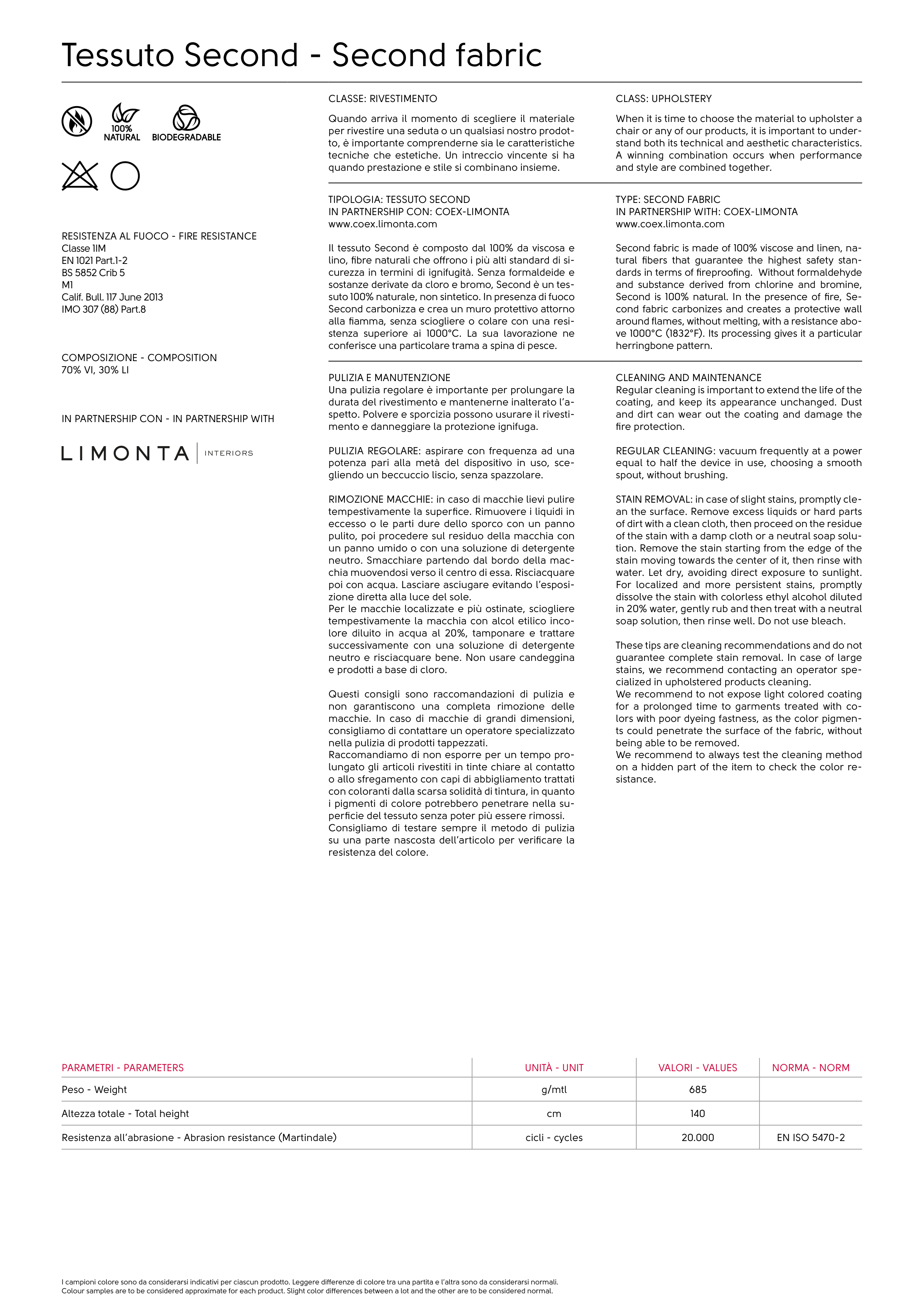I campioni colore sono da considerarsi indicativi per ciascun prodotto. Leggere differenze di colore tra una partita e l’altra sono da considerarsi normali.
Colour samples are to be considered approximate for each product. Slight color differences between a lot and the other are to be considered normal.
Tessuto Second - Second fabric
CLASSE: RIVESTIMENTO
CLASS: UPHOLSTERY
Quando arriva il momento di scegliere il materiale
per rivestire una seduta o un qualsiasi nostro prodot-
to, è importante comprenderne sia le caratteristiche
tecniche che estetiche. Un intreccio vincente si ha
quando prestazione e stile si combinano insieme.
When it is time to choose the material to upholster a
chair or any of our products, it is important to under-
stand both its technical and aesthetic characteristics.
A winning combination occurs when performance
and style are combined together.
TIPOLOGIA: TESSUTO SECOND
IN PARTNERSHIP CON: COEX-LIMONTA
www.coex.limonta.com
Il tessuto Second è composto dal 100% da viscosa e
lino, fibre naturali che offrono i più alti standard di si-
curezza in termini di ignifugità. Senza formaldeide e
sostanze derivate da cloro e bromo, Second è un tes-
suto 100% naturale, non sintetico. In presenza di fuoco
Second carbonizza e crea un muro protettivo attorno
alla fiamma, senza sciogliere o colare con una resi-
stenza superiore ai 1000°C. La sua lavorazione ne
conferisce una particolare trama a spina di pesce.
TYPE: SECOND FABRIC
IN PARTNERSHIP WITH: COEX-LIMONTA
www.coex.limonta.com
Second fabric is made of 100% viscose and linen, na-
tural fibers that guarantee the highest safety stan-
dards in terms of fireproofing. Without formaldehyde
and substance derived from chlorine and bromine,
Second is 100% natural. In the presence of fire, Se-
cond fabric carbonizes and creates a protective wall
around flames, without melting, with a resistance abo-
ve 1000°C (1832°F). Its processing gives it a particular
herringbone pattern.
PULIZIA E MANUTENZIONE
Una pulizia regolare è importante per prolungare la
durata del rivestimento e mantenerne inalterato l’a-
spetto. Polvere e sporcizia possono usurare il rivesti-
mento e danneggiare la protezione ignifuga.
PULIZIA REGOLARE: aspirare con frequenza ad una
potenza pari alla metà del dispositivo in uso, sce-
gliendo un beccuccio liscio, senza spazzolare.
RIMOZIONE MACCHIE: in caso di macchie lievi pulire
tempestivamente la superfice. Rimuovere i liquidi in
eccesso o le parti dure dello sporco con un panno
pulito, poi procedere sul residuo della macchia con
un panno umido o con una soluzione di detergente
neutro. Smacchiare partendo dal bordo della mac-
chia muovendosi verso il centro di essa. Risciacquare
poi con acqua. Lasciare asciugare evitando l’esposi-
zione diretta alla luce del sole.
Per le macchie localizzate e più ostinate, sciogliere
tempestivamente la macchia con alcol etilico inco-
lore diluito in acqua al 20%, tamponare e trattare
successivamente con una soluzione di detergente
neutro e risciacquare bene. Non usare candeggina
e prodotti a base di cloro.
Questi consigli sono raccomandazioni di pulizia e
non garantiscono una completa rimozione delle
macchie. In caso di macchie di grandi dimensioni,
consigliamo di contattare un operatore specializzato
nella pulizia di prodotti tappezzati.
Raccomandiamo di non esporre per un tempo pro-
lungato gli articoli rivestiti in tinte chiare al contatto
o allo sfregamento con capi di abbigliamento trattati
con coloranti dalla scarsa solidità di tintura, in quanto
i pigmenti di colore potrebbero penetrare nella su-
perficie del tessuto senza poter più essere rimossi.
Consigliamo di testare sempre il metodo di pulizia
su una parte nascosta dell’articolo per verificare la
resistenza del colore.
CLEANING AND MAINTENANCE
Regular cleaning is important to extend the life of the
coating, and keep its appearance unchanged. Dust
and dirt can wear out the coating and damage the
fire protection.
REGULAR CLEANING: vacuum frequently at a power
equal to half the device in use, choosing a smooth
spout, without brushing.
STAIN REMOVAL: in case of slight stains, promptly cle-
an the surface. Remove excess liquids or hard parts
of dirt with a clean cloth, then proceed on the residue
of the stain with a damp cloth or a neutral soap solu-
tion. Remove the stain starting from the edge of the
stain moving towards the center of it, then rinse with
water. Let dry, avoiding direct exposure to sunlight.
For localized and more persistent stains, promptly
dissolve the stain with colorless ethyl alcohol diluted
in 20% water, gently rub and then treat with a neutral
soap solution, then rinse well. Do not use bleach.
These tips are cleaning recommendations and do not
guarantee complete stain removal. In case of large
stains, we recommend contacting an operator spe-
cialized in upholstered products cleaning.
We recommend to not expose light colored coating
for a prolonged time to garments treated with co-
lors with poor dyeing fastness, as the color pigmen-
ts could penetrate the surface of the fabric, without
being able to be removed.
We recommend to always test the cleaning method
on a hidden part of the item to check the color re-
sistance.
RESISTENZA AL FUOCO - FIRE RESISTANCE
Classe 1IM
EN 1021 Part.1-2
BS 5852 Crib 5
M1
Calif. Bull. 117 June 2013
IMO 307 (88) Part.8
PARAMETRI - PARAMETERS
UNITÀ - UNIT
VALORI - VALUES
NORMA - NORM
Peso - Weight
g/mtl
685
Altezza totale - Total height
cm
140
Resistenza all’abrasione - Abrasion resistance (Martindale)
cicli - cycles
20.000
EN ISO 5470-2
IN PARTNERSHIP CON - IN PARTNERSHIP WITH
COMPOSIZIONE - COMPOSITION
70% VI, 30% LI


